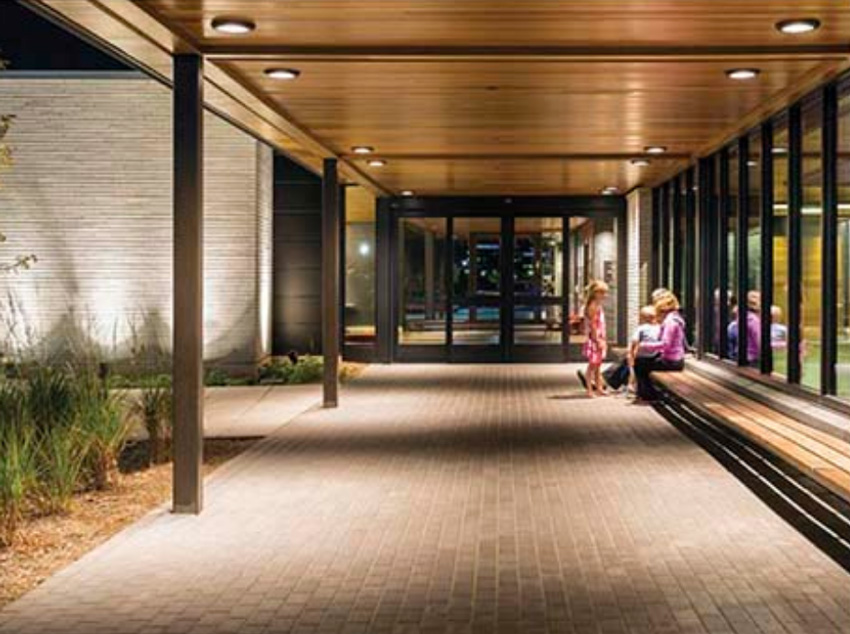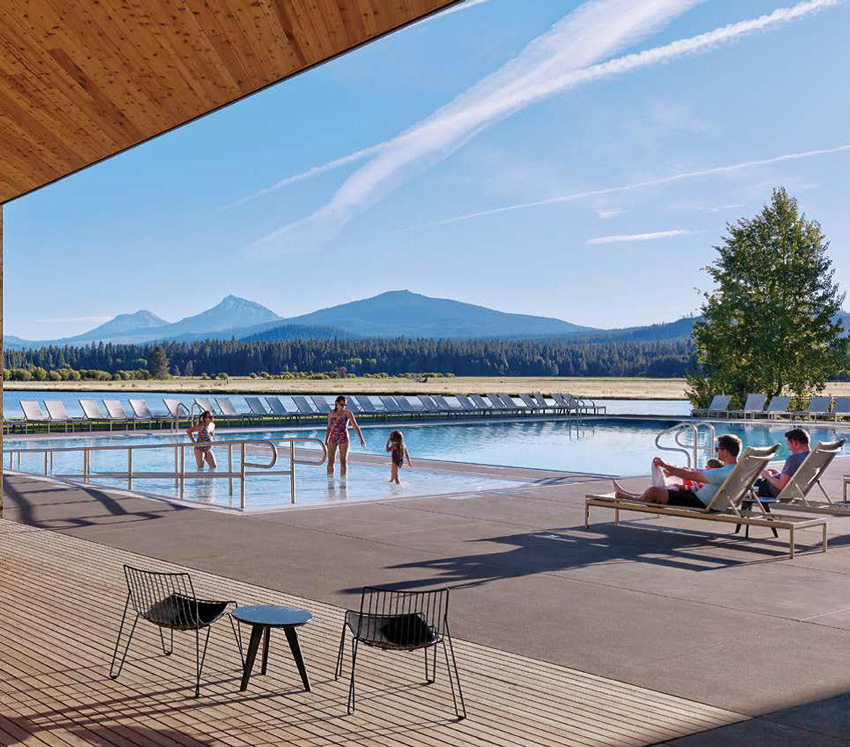Design for the Public Realm
Appropriateness of Western Red Cedar for Public Spaces
Western red cedar has long been known for its durability. Its botanical name is Thuja plicata, derived from thujaplicin, which is a chemical substance that is found in these trees and serves as a natural fungicide, thereby preventing the wood from rotting. Hence, its durability lies in its natural resistance to rot, decay, and insects.
Western red cedar is also a sustainable, resilient tree species. It has one of the widest growth ranges on the West Coast, as it grows in lush forests and mountainsides as well as many forested swamps and stream banks within its range. “Western red cedar is one of North America’s great renewable resources. The range of western red cedar is essentially in two segments: a Coast Range-Cascade Range segment from southeastern Alaska to northwestern California and a Rocky Mountain segment from British Columbia and Alberta to Idaho and Montana.” Although the species is slow growing, it is naturally durable and has one of the longest life spans of any North American softwood. According to U.S. Forest Service reports, this species tolerates shade very well and thus can survive in forest understories. In addition, U. S. Forest Service predictions indicate that this species’ growth rates are likely to thrive as accelerated climate change occurs.1
Western red cedar also has a broad range of aesthetic qualities, making it a popular choice in design applications. It is pitch and resin free, which means that it accepts and holds a variety of finishes. Western red cedar provides both color and texture for projects, as it has naturally rich tonal properties, and the knotty grades of decking and siding add textural enhancements to designs. Paul Mackie, known as “Mr. Cedar” in the building industry, is an expert in the properties of western red cedar. In his opinion, “Western red cedar is simply one of the world’s most beautiful woods. No man-made material can duplicate its naturally luxurious appearance.”
And Corey V. Martin, principal at Hacker Architects, states, “Cedar creates spaces that other materials cannot. Without it, the fundamental form or volume would not have the same power. Western red cedar allows the buildings to be of the land in a perfect way—the building, land, and material can be one.”
Western Red Cedar's Environmental Appropriateness
Climate change and impacts made by continued development are adversely affecting the environment and in turn our communities and health. By adhering to LEED and SITES criteria in designs, design teams can effectively reduce these impacts by specifying products that have been verified for improved environmental life-cycle impacts. Products whose manufacture or harvesting reduce negative environmental impacts can be certified as environmentally friendly. Western red cedar is third-party certified environmentally friendly in the way that it’s harvested and its forests are managed.
Over the past 15 years, the green building industry has invested a significant amount of resources to responsible procurement of forest products. The U.S. Green Building Council (USGBC) encourages the use of construction products and materials carrying environmental product declarations (EPDs), which are calculated through a life-cycle assessment (LCA). The LCA is evaluated through the LEED Green Building point system. EPDs contribute to LEED points. EPDs are created according to internationally harmonized standards and are third-party verified, ensuring that the results for the product are valid. Products with third-party certification (Type III), including external verification, are valued as one-half of a point for credit achievement calculation through LEED. According to its website, the USGBC recently developed a new pilot alternative compliance path (ACP) credit for its LEED rating system. The ACP is designed to further advance environmentally responsible forest management and help to remove the use of illegal wood by promoting responsible wood sourcing and chain of custody.
The green characteristics of any material is the LCA which is a detailed analysis that provides guidance on the environmental friendliness of a product throughout the product’s design. According to Dassault Systèmes, the company that makes the automated LCA tools, “The (LCA) analysis looks at a product’s entire life, which encompasses extraction, material production, manufacturing, product use, end-of-life disposal, and all of the transportation that occurs between these stages.”
LCA studies can provide the designer with comparisons of multiple material types. Some recent studies done by the research laboratory FPInnovations-Forintek have compared the benefits of the Western Red Cedar wood species Thuja plicata against non-wood building materials for residential siding and decking. The studied materials included products such as wood-plastic composite, fiber-cement materials, and extruded vinyl. This LCA study measured these products in areas such as resource and water use, energy requirements, transportation implications, and waste creation. The natural wood showed substantial advantages for sustainable design. John Wagner, a sustainability consultant and editor in chief of Green Builder Magazine, has acknowledged that the LCA comparative study showed western red cedar to be the least environmentally “burdensome” and lowest consumer of nonrenewable resources such as fossil fuels.
Western Red Cedar in Public Placemaking Applications
Environmental considerations are only a part of the multifaceted design analysis conducted by project teams when determining the best materials for a given application. The design and construction of public-realm spaces call for materials that are low maintenance and durable to meet diminishing public maintenance budgets. Western red cedar’s consistent density and ability to lay flat make it an appropriate material in the construction of both a safe and aesthetically attractive public environment. The ability to lay flat allows for crisp, clean surfaces to be created that will not warp or check and thus create unsightly and unsafe surfaces. Its density and durability make it an appropriate material for creating an outdoor shade pergola or arbor or providing an attractive fence to delineate the public space.
Aesthetic considerations and human interaction are not part of the protocols for life-cycle assessments or maintenance of products, but aesthetics and human interaction are important considerations in design projects. Aesthetic qualities contribute to what people find attractive about a place. “People who like being outdoors usually like being part of their natural surroundings,” says Paul Mackie of WRCLA, articulating the appeal of natural products as compared to the synthetic character of some composite wood materials. “If that’s the case, choosing a natural product like cedar is the way to go,” he adds. “People who like to be outdoors or closer to nature prefer to spend time with all-natural materials.”
Social ecologist Stephen R. Kellert has studied the science of biophilia and has authored a book on the subject titled Biophilic Design. The book lists 75 attributes to what is termed “restorative environmental design.” The attributes include natural materials, natural shapes and forms, and natural patterns and processes. Western red cedar provides an aesthetically pleasing material for construction. The exposed wood grain and knots present natural shapes and forms, the natural textures present natural patterns, and the wood is a natural material. In addition, some architects and designers integrate the various cuts of wood, alternating flat and vertical grains for visual effect.
Western red cedar feels soft to the touch and never overheats, whereas synthetic decks can feel scratchy and have a tendency to get uncomfortably hot. The cool-touch, smooth surface characteristics are optimal for outdoor pool decks, condominium roof decks, or other public spaces where bare feet may come in contact with the deck surface.
Western red cedar has been used on a variety of public projects due to its durability, natural resistance to rot and insects, attractive texture, ability to hold a wide variety of finishes, and even the calming effect that wood has on people. Western red cedar has been specified as a preferred material for boardwalks, outdoor pavilions, rooftop decks, and site furniture. Some examples of its many uses are featured in case studies throughout this course.
Notice

www.bklighting.com/DE

www.bisonip.com

www.realcedar.com











